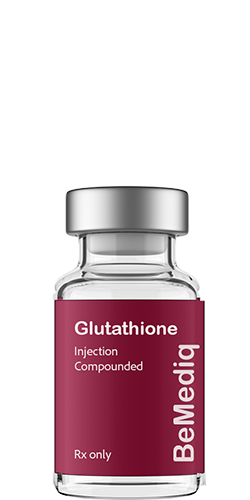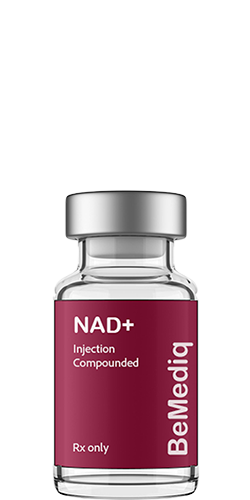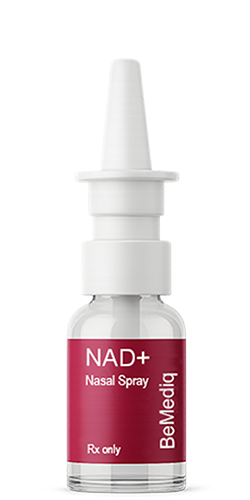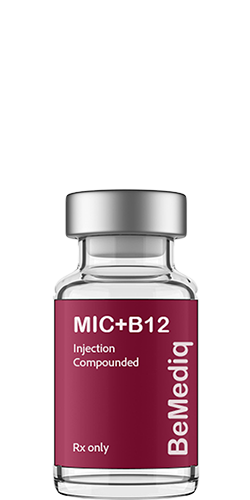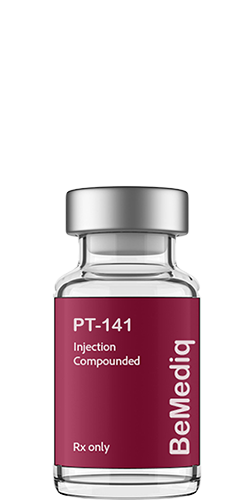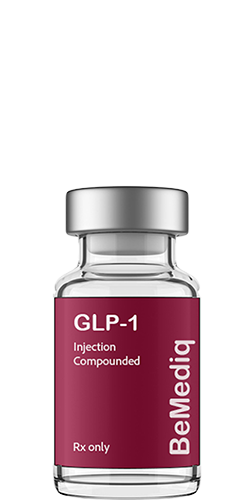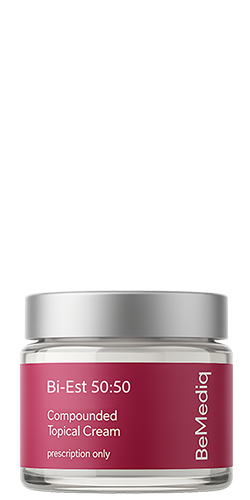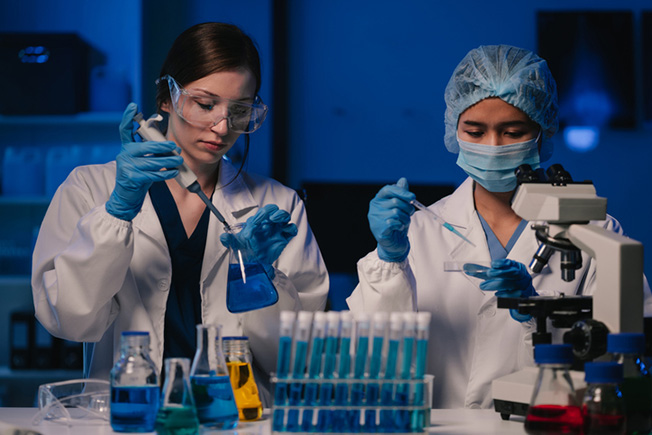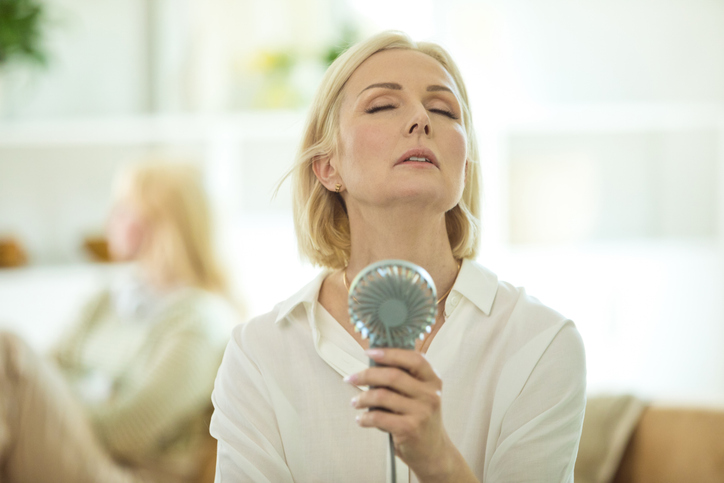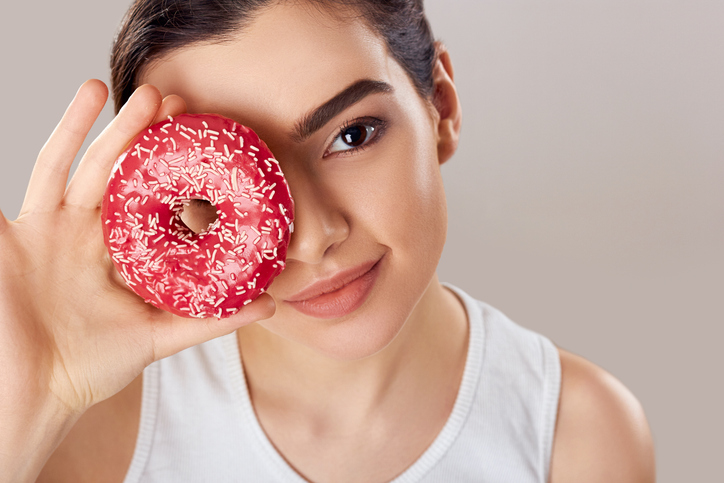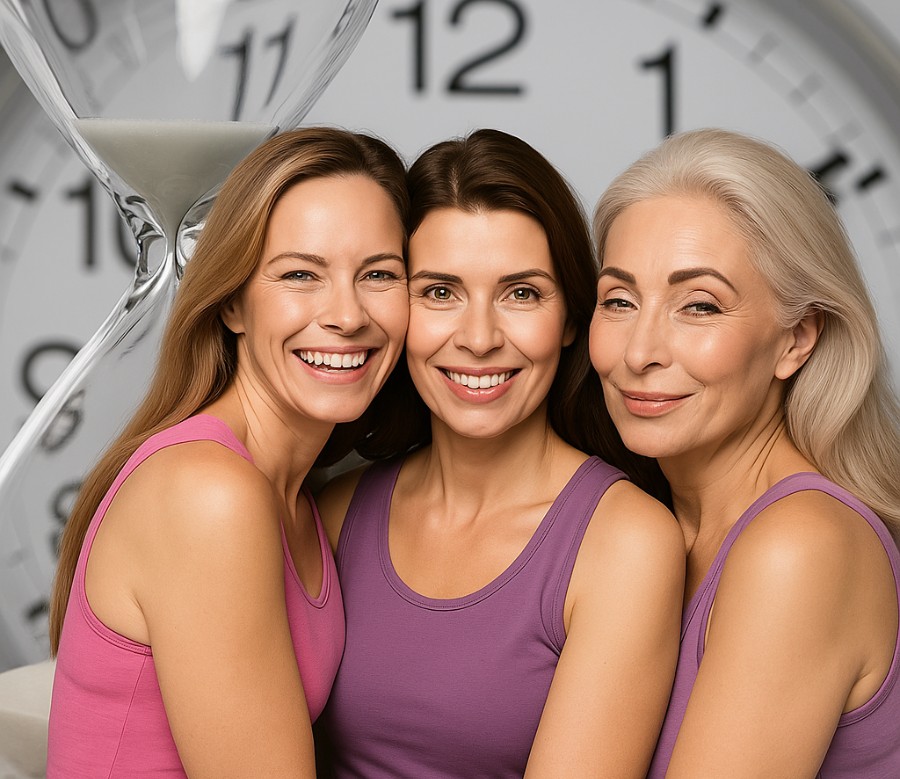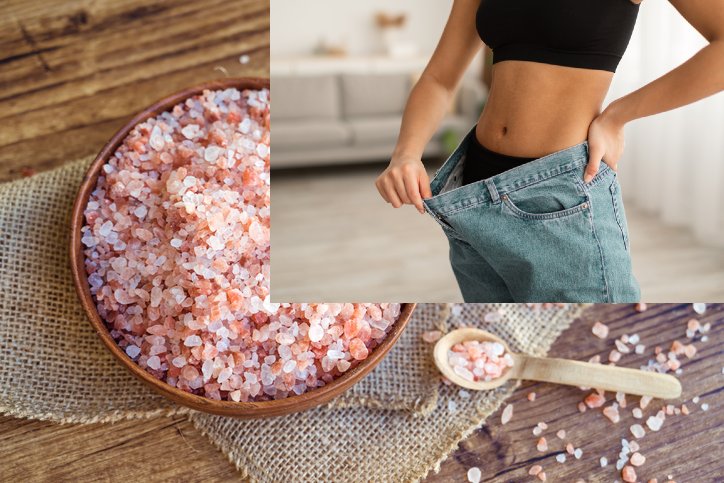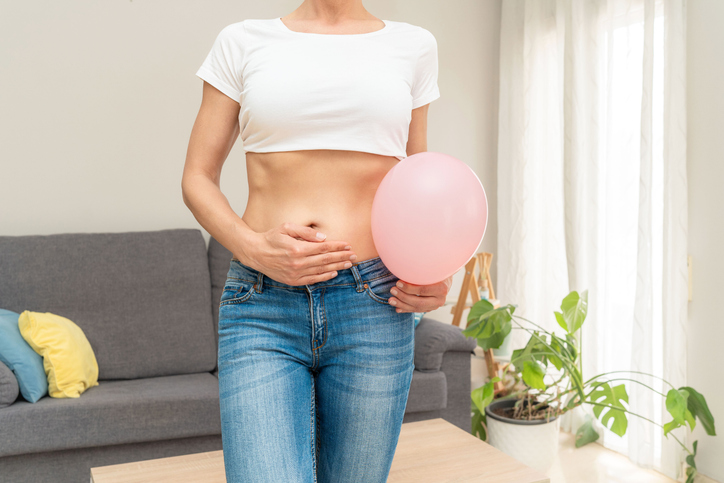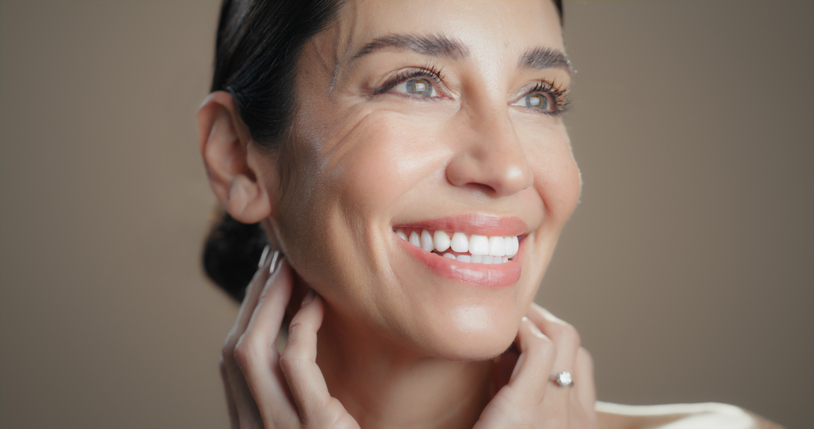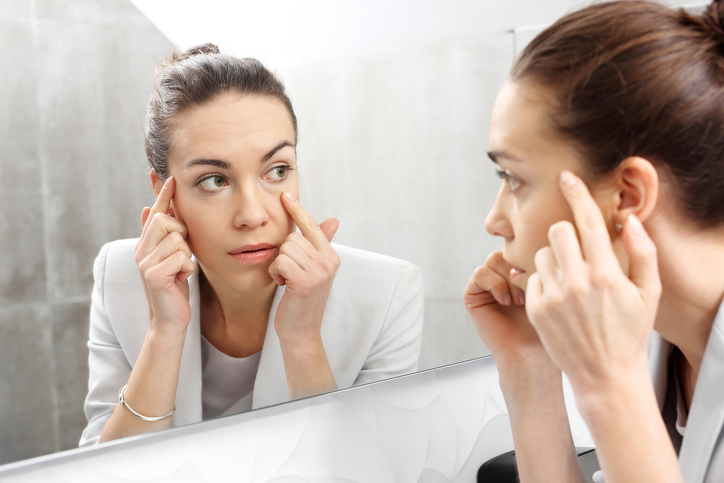Because the form of HRT you choose can shape the way you feel.

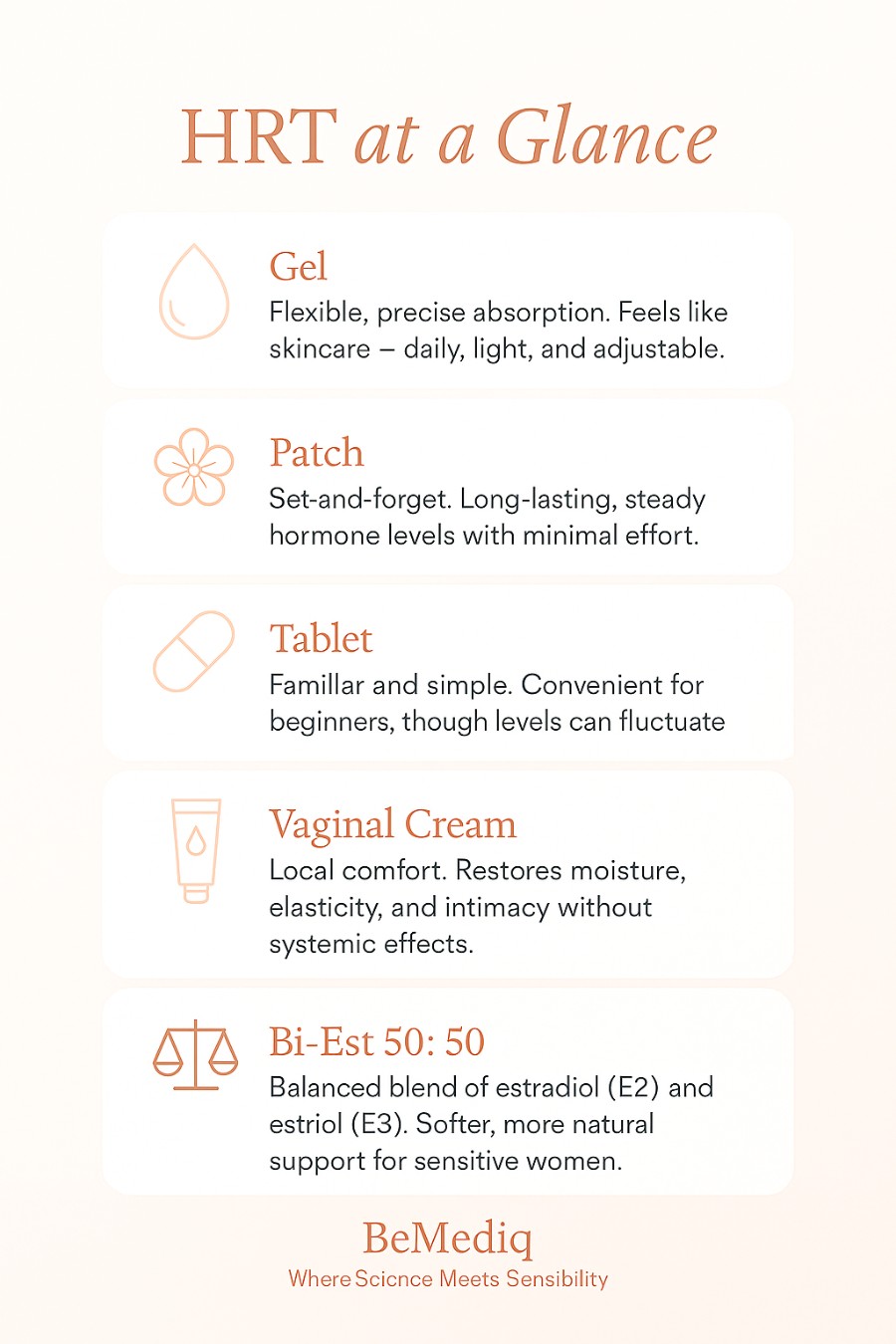
Key Takeaways — HRT at a Glance:
- Gel: Flexible, precise absorption. Feels like skincare – daily, light, and adjustable.
- Patch: Set-and-forget. Long-lasting, steady hormone levels with minimal effort.
- Tablet: Familiar and simple. Convenient for beginners, though levels can fluctuate slightly.
- Vaginal Estradiol Cream: Local comfort. Restores moisture and ease without systemic effects.
- Bi-Est: softer balance. Gentle dual-estrogen blend ideal for sensitive women.
Intro
Every woman’s hormonal story is unique.
For some, balance is found in a few quiet drops of gel each morning — a small ritual that feels more like skincare than medicine.
For others, it’s a patch, discreetly placed, that travels with them through workdays and weekends, quietly restoring what time has shifted.
Hormone therapy isn’t only about replacing what’s missing.
It’s about how your body receives support — how naturally, how evenly, and how in tune with your daily rhythm.
The right form doesn’t just deliver hormones; it delivers peace of mind.
Let’s explore the options, and what makes each one unique.
Why the Delivery Method Matters
Hormone Replacement Therapy (HRT) is never one-size-fits-all.
Two women may take the same estrogen and experience completely differentresults — because it’s not only about what you take, but how your body absorbs it.
Each route — gel, patch, tablet, or cream — has its own rhythm, interacting differently with your skin, liver, and metabolism.
The goal is steady estrogen levels that feel invisible yet effective —supporting mood, skin, and sleep without unnecessary fluctuations.
(See also Part V – Should You Consider HRT? (coming soon))
Estradiol Gel —The Flexible Choice
Morning light. A moment of calm before the day begins.
A cool touch of gel on warm skin — invisible, effortless. Within minutes, your body recognizes what it’s receiving and absorbs it like its own.
Transdermal gels bypass the liver entirely, offering smooth, direct absorption and allowing precise, gentle titration of dose.
It’s hormone therapy that feels more like a skincare ritual — intuitive, minimal, and elegant.
Why women love it
• Light texture and fast absorption
• Adjustable dosing for fine-tuned balance
• Stable estrogen levels when used consistently
Keep in mind
• Estradiol gel must be applied daily
• Avoid skin-to-skin contact until dry
Estradiol Gel is ideal for women who want quiet precision — a morning ritual of calm and control.
Case : The Gentle Adjuster
Mara, 47, battled restless nights and anxiety. Tablets left her dizzy. A low-dose transdermal gel steadied her within weeks — clear mornings, calm evenings, and deep sleep she thought she’d lost.
Estradiol Patch — The Effortless Routine
You place it once. It stays for days.
No reminders, no daily steps — just a patch that works silently beneath your clothes.
For many women, this simplicity feels like freedom.
Patches deliver estrogen continuously through the skin, maintaining stable levels that mirror the body’s natural rhythm. They are discreet, low-maintenance, and ideal for active or traveling lifestyles.
Why they work
• Replaced once or twice a week
• Provide constant delivery
Considerations
• May cause mild irritation or adhesive marks
• Slight visibility depending on placement
Estradiol patches are perfect for those who value consistency, simplicity, and stability.
Case : TheTraveler
Claudia, 52, crosses time zones weekly. Remembering pills was impossible; patches changed that. Two per week, no disruption — her symptoms stayed steady wherever she landed.
Estradiol Tablets — The Familiar Format
Sometimes balance begins with something familiar.
A small tablet after breakfast, a sip of water, and the quiet reassurance of routine.
Oral estrogen is often a woman’s first step into hormone therapy — accessible, simple, and easy to integrate.
Because it passes through the liver before circulation, absorption may vary slightly, but for many, this form offers comfort and predictability.
Why women choose them
• Familiar daily rhythm
• Straight forward, affordable
Considerations
• Slightly fluctuating hormone levels
• Not ideal for women with liver or clotting disorders
Estradiol Tablets are best for women transitioning from oral contraceptives or those easing gently into therapy.
Case: The Gradual Transition
Anna, 45, felt constant fatigue. Her clinician began with oral estrogen to ease her body into change, then transitioned her to a patch for steadier balance.
Vaginal Estradiol Creams — Targeted Comfort
Vaginal estrogen works locally — soothing dryness, tenderness, and the subtledis comfort that can affect confidence and intimacy.
It doesn’t flood the bloodstream; it simply replenishes where estrogen matters most for daily comfort and connection.
How they work
• Applied directly to vaginal tissue
• Minimal systemic absorption
• Restores moisture, elasticity, and microbiome health
When to use
• Alone or combined with systemic HRT
• Typically 2–3 × per week
Vaginal Estradiol Cream is a localized, low-dose therapy for comfort, confidence, and closeness.
Case: The Intimate Renewal
Nina, 54, felt dryness that dimmed intimacy. Her clinician prescribed local estradiol cream twice a week. Within a month, comfort — and connection —quietly returned.
Learn About Intimate Comfort (coming soon).
Bi-Est 50:50 — A Softer Balance
A balanced blend of estradiol(E2) and estriol (E3) in equal parts, this compounded cream mirrors the body’s gentler estrogenic pattern.
Clinicians often describe it as the “soft focus” version of HRT — still powerful, but kinder to sensitive systems.
Why clinicians use it
• Milder receptor activation
• Less breast tenderness or bloating
• Suitable for estrogen-sensitive women
For those seeking hormonal support that feels intuitive, not intrusive.
Case: The Sensitive Balancer
Sophie, 49, reacted to pure estradiol with headaches and tension. Switchingto Bi-Est 50:50 brought steadiness — “It felt softer on my body,” she said.
Read: Bi-Est 50:50 Explained (coming soon)
How Do You Know If HRT Is Right for You?
The first step isn’t choosing between a gel, patch, or tablet — it’s understanding if your body truly needs hormonal support at all. (Read: The Complete Guide to Perimenopause & Menopause)
Many symptoms that resemble estrogen decline — fatigue, anxiety, sleep disruption, or weight shifts — can also arise from thyroid imbalance, stress-related cortisol changes, or nutrient deficiencies.
That’s why clarity begins with data.
At-home lab testing offers a quiet kind of insight: it shows where your hormone levels really stand, how your cycle is shifting, and whether your estrogen, progesterone, and DHEA are still in balance.
Knowing your baseline helps your provider determine whether HRT is right for you — and if so, which form and dosage will align best with your unique rhythm.
Beyond the Form: Personalized HRT, Simplified
The form of HRT is only one part of your treatment. At BeMediq, every prescription is compounded by licensed U.S. pharmacies, reviewedby clinicians, and shipped discreetly to your door — ensuring quality, purity, and flexibility.
No matter the HRT-format, the goal is the same: steady hormones, fewer symptoms, and a genuine return to balance.
Your Next Step
If you’re ready to understand which option fits you best, your BeMediq provider can help design a plan tailored to your body and goals.
Key Takeaways
The HRT — Form Matters as Much as Formula
The effectiveness of hormone therapy depends not only on what you take, but how your body receives it. Each delivery method — gel, patch, tablet, or cream — affects absorption, metabolism, and daily rhythm differently.
Transdermal Estrogen — Forms Offer the Most Natural Balance
Gels and patches deliver estrogen through the skin, avoiding liver metabolism and providing smooth, steady levels. They are often best suited for women seeking physiological hormone replacement with minimal fluctuation.
Oral Estrogen Can Be Convenient, but Less Stable
Tablets are familiar and accessible but pass through the liver first, which can alter hormone consistency and increase clotting risk in some women.
Local Vaginal Estrogen Targets Comfort
Low-dose vaginal creams or tablets act locally, improving dryness and intimacy without affecting systemic levels. They can be used alone or alongside other HRT forms.
Bi-Est 50:50 Offers a Gentler Option
The combination of estradiol (E2) and estriol (E3) provides a softer hormonal effect — ideal for women sensitive to standard estradiol therapy.
Personalization Is Essential
There is no universal “best” form. Clinicians consider symptoms, preferences, medical history, and lifestyle when designing a treatment plan. Personalization improves comfort, safety, and adherence.
Disclaimer: These statements are for informational purposes only and have not been evaluated by the Food and Drug Administration. This content is not intended to diagnose,treat, cure, or prevent any disease. Always consult a licensed healthcare provider before starting any supplement or therapy.

Written by Elena B.,Women's Wellness Coach
About the Author: Elena B. is an Integrative Health Educator (non-clinical) with a background in holistic health, hormonal resilience, and longevity science. Her mission is to help women reconnect with their biology, understand their cycles, and make empowered lifestyle choices - without medical claims or therapeutic prescriptions.
FAQ — Understanding Your HRT Options
1. How do I know if I actually need hormone therapy?
The clearest indicator comes from both how you feel and what your labs show.
If you experience mood changes, hot flashes, poor sleep, or weight shifts, testing your estrogen, progesterone, and thyroid levels can clarify whether hormonal decline is the cause — or if other factors like stress or nutrient imbalances play a role.
2. Should I consider HRT if I’m over 45?
Not necessarily — but it may be time to check in.
For many women, the years between 45 and 50 mark the beginning of perimenopause, when hormone levels, especially progesterone and estradiol, start to fluctuate.
You don’t need to wait for your period to stop completely to start thinking about hormone support.
If you notice changes in your mood, sleep, cycle, or energy, these can be early signs that your body is entering the transition — and your hormones are recalibrating rather than disappearing.
That doesn’t automatically mean you need HRT.
It means it’s the right moment to test — to understand where your hormones currently stand and whether natural support, lifestyle adjustments, or medical options would serve you best.
A good next step: Ask your provider for a comprehensive hormone panel (Estradiol, Progesterone, FSH, LH, DHEA-S, Cortisol, and Thyroid levels) or explore at-home testing options for insight before making decisions.
3. What’s the safest form of HRT?
According to clinical research (Menopause Society, 2023), transdermal estrogen — delivered via gel or patch — has the most favorable safety profile for most women. It bypasses the liver, maintains steady hormone levels, and carries a lower risk of clotformation compared to oral estrogen.
4. Can I combine different forms of estrogen therapy?
Yes — many clinicians use a combined approach, such as a transdermal patch for systemic balance plus a vaginal cream for local comfort. This ensures stable hormone levels and targeted support for vaginal dryness or discomfort.
5. What exactly is Bi-Est 50:50?
Bi-Est is a compounded blend of two natural estrogens: estradiol (E2) and estriol (E3), in equal parts. It offers softer receptor activation and is often chosen by women who are sensitive to pure estradiol.
Think of it as a more nuanced, gentle approach to restoring balance.
6. When should I start HRT — before or after menopause?
The ideal time is often during perimenopause — when hormone levels start fluctuating but haven’t dropped completely.
Starting too early or too late can reduce effectiveness, which is why baseline testing and clinical guidance are key before beginning.
7. Do I still need progesterone if I use estrogen-only therapy?
If you still have an uterus, yes — progesterone protects the uterine lining from overgrowth caused by estrogen.
Micronized bioidentical progesterone is most often recommended for its natural compatibility and calming effects on sleep and mood.
8. Can lifestyle and nutrition reduce the need for HRT?
Sometimes, yes. Supporting liver detox pathways, managing stress, balancing blood sugar, and ensuring nutrient sufficiency (especially B vitamins, magnesium, and choline) can all influence how your body metabolizes hormones. (Read: The Liver-Hormone Connection: A Natural Way to Reduce Perimenopause Symptoms (Part I))
However, when levels drop significantly, lifestyle alone may not restore balance — HRT can then complement your foundation of healthy habits.
Find Your Ideal Clinician Guided Hormone Plan
Disclaimer: These statements are for informational purposes only and have not been evaluated by the Food and Drug Administration. This content is not intended to diagnose,treat, cure, or prevent any disease. Always consult a licensed healthcare provider before starting any supplement or therapy.
References
L’Hermite M. (2013). HRT optimization, using transdermal estradiol plus micronized progesterone, a safer HRT. Climacteric, 16 (Suppl 1): 44–53. DOI:10.3109/13697137.2013.808563

